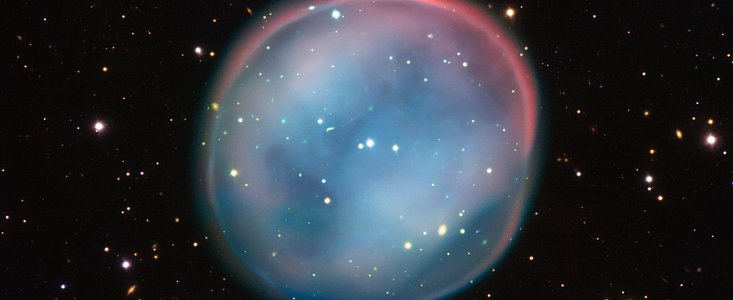This Nebula is the result of a dying star
Wikipedia.org defines a nebula as “an interstellar cloud of dust, hydrogen, helium and other ionized gases”. And from there it can get a bit bizarre. Some form from the gravitational forces on gases that get denser and denser as time goes on until at some point a star may be born at the center.
In other cases, if a star just can’t take it’s own gravity anymore and collapses in on itself, a tremendous explosion called a supernova spews material out in all directions. Because of the energy given off in that explosion, much of the material is vaporized (or more technically ionized), and the gas bubble can grow to tremendous sizes.
The photo released by ESO below is a planetary nebulae, but there are several others. There are dark nebulae, proto-planetary nebulae, supernova remnants, emission nebulae and others.
Take a look at the photo below and press release excerpts below. It’s worth a share as well, this stuff is simply fascinating …
eso1532-en-us — Photo Release
The Ghost of a Dying Star
5 August 2015
This extraordinary bubble, glowing like the ghost of a star in the haunting darkness of space, may appear supernatural and mysterious, but it is a familiar astronomical object: a planetary nebula, the remnants of a dying star. This is the best view of the little-known object ESO 378-1 yet obtained and was captured by ESO’s Very Large Telescope in northern Chile. Original photo source: ESO Cosmic Gems Programme
Nicknamed the Southern Owl Nebula, this shimmering orb is a planetary nebula with a diameter of almost four light-years. Its informal name relates to its visual cousin in the northern hemisphere, the Owl Nebula. ESO 378-1 [1], which is also catalogued as PN K 1-22 and PN G283.6+25.3, is located in the constellation of Hydra (The Female Water Snake).
Like all planetary nebulae, ESO 378-1 is a relatively short-lived phenomenon, lasting only a few tens of thousands of years, compared to a typical stellar lifetime of several billion years [2].
Planetary nebulae are created by the ejected and expanding gas of dying stars. Although they are brilliant and intriguing objects in the initial stages of formation, these bubbles fade away as their constituent gas moves away and the central stars grow dimmer.
…… After the planetary nebula has faded away, the leftover stellar remnant will burn for another billion years before consuming all its remaining fuel. It will then become a tiny — but hot and very dense — white dwarf that will slowly cool over billions of years. The Sun will produce a planetary nebula several billion years in the future and will afterwards also spend its twilight years as a white dwarf.
Notes
[1] The ESO in the name of this object refers to a catalogue of objects compiled in the 1970s and 80s from careful inspection of new photographs taken with the ESO 1-metre Schmidt telescope at La Silla.
[2] The lifetime of a planetary nebula as a fraction of a star’s life is about the same as the life of a soap bubble compared to the age of the child who blows it.
…… This is a translation of ESO Press Release eso1532.
Please visit ESO for the full story
Source: ESO
CHECK OUT THE VIDEO OF ANOTHER PLANETARY NEBULA ON THE NEXT PAGE! …

